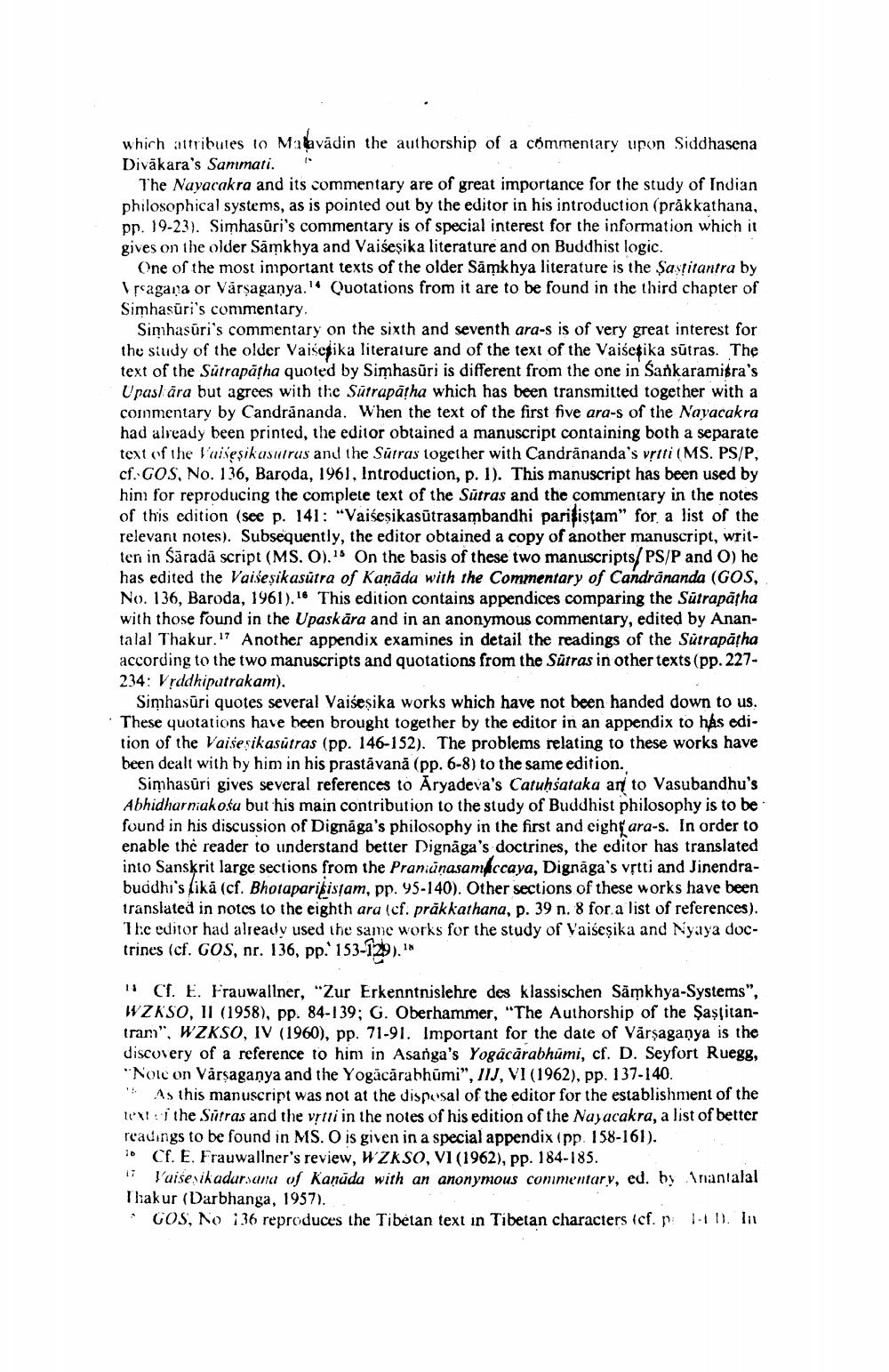Book Title: Nyayachakra Lekh Author(s): J W De Jong Publisher: J W De Jong View full book textPage 4
________________ which attributes to Maavädin the authorship of a commentary upon Siddhasena Diväkara's Sammati. The Nayacakra and its commentary are of great importance for the study of Indian philosophical systems, as is pointed out by the editor in his introduction (pråkkathana, pp. 19-23). Simhasūri's commentary is of special interest for the information which it gives on the older Samkhya and Vaiśeşika literature and on Buddhist logic. One of the most important texts of the older Samkhya literature is the Saștitantra by Vrsagana or Varṣaganya. Quotations from it are to be found in the third chapter of Simhasüri's commentary. Simhasūri's commentary on the sixth and seventh ara-s is of very great interest for the study of the older Vaisepika literature and of the text of the Vaisesika sūtras. The text of the Sutrapatha quoted by Simhasūri is different from the one in Sankaramitra's Upaskāra but agrees with the Sutrapatha which has been transmitted together with a commentary by Candrananda. When the text of the first five ara-s of the Nayacakra had already been printed, the editor obtained a manuscript containing both a separate text of the Vaisesikasutras and the Sutras together with Candrananda's vṛtti (MS. PS/P, cf. GOS, No. 136, Baroda, 1961, Introduction, p. 1). This manuscript has been used by him for reproducing the complete text of the Sutras and the commentary in the notes of this edition (see p. 141: "Vaiśeṣikasūtrasambandhi parisistam" for a list of the relevant notes). Subsequently, the editor obtained a copy of another manuscript, written in Sarada script (MS. O). 15 On the basis of these two manuscripts/PS/P and O) he has edited the Vaiseṣikasutra of Kanada with the Commentary of Candrananda (GOS, No. 136, Baroda, 1961).1 This edition contains appendices comparing the Sūtrapatha with those found in the Upaskāra and in an anonymous commentary, edited by Anantalal Thakur." Another appendix examines in detail the readings of the Sutrapatha according to the two manuscripts and quotations from the Sutras in other texts (pp. 227234: Vṛddhipatrakam). Simhasūri quotes several Vaiseṣika works which have not been handed down to us. These quotations have been brought together by the editor in an appendix to has edition of the Vaiseṣikasutras (pp. 146-152). The problems relating to these works have been dealt with by him in his prastāvanā (pp. 6-8) to the same edition. Simhasūri gives several references to Aryadeva's Catuḥsataka an to Vasubandhu's Abhidharmakosa but his main contribution to the study of Buddhist philosophy is to be found in his discussion of Dignaga's philosophy in the first and eight ara-s. In order to enable the reader to understand better Dignaga's doctrines, the editor has translated into Sanskrit large sections from the Praniānasamaccaya, Dignaga's vṛtti and Jinendrabuddhi's lika (cf. Bhotaparipistam, pp. 95-140). Other sections of these works have been translated in notes to the eighth ara (cf. prākkathana, p. 39 n. 8 for a list of references). The editor had already used the same works for the study of Vaiseṣika and Nyaya doctrines (cf. GOS, nr. 136, pp. 153-129). I 18 14 Cf. E. Frauwallner, "Zur Erkenntnislehre des klassischen Sämkhya-Systems", WZKSO, II (1958), pp. 84-139; G. Oberhammer, "The Authorship of the Şaştitantram", WZKSO, IV (1960), pp. 71-91. Important for the date of Varsaganya is the discovery of a reference to him in Asanga's Yogacārabhūmi, cf. D. Seyfort Ruegg, "Note on Varṣaganya and the Yogācārabhūmi”, IIJ, VI (1962), pp. 137-140. As this manuscript was not at the disposal of the editor for the establishment of the text: the Sutras and the vṛtti in the notes of his edition of the Nayacakra, a list of better readings to be found in MS. O is given in a special appendix (pp. 158-161). 16 Cf. E. Frauwallner's review, WZKSO, VI (1962), pp. 184-185. Vaise ikadarsana of Kanada with an anonymous commentary, ed. by Anantalal Thakur (Darbhanga, 1957). GOS, No 136 reproduces the Tibetan text in Tibetan characters (cf. p 1-1 D. In 17Page Navigation
1 2 3 4 5 6
